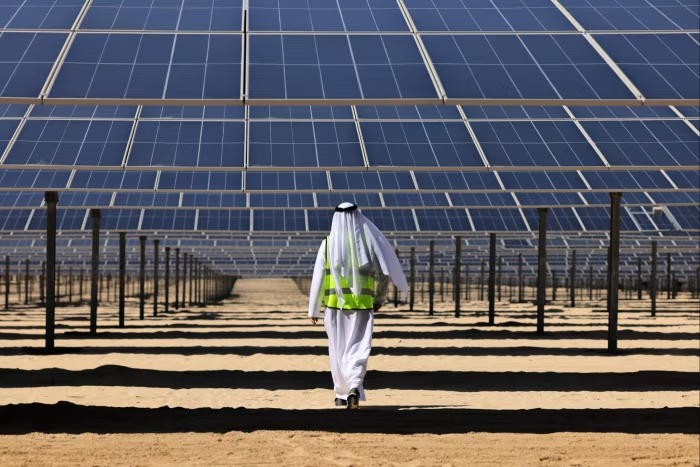Saudi Arabia Invests $10 Billion into Renewable Energy Projects

Saudi Arabia has taken a major step towards reshaping its energy portfolio, investing $10 billion in renewable energy initiatives. This ambitious funding underscores Saudi Arabia’s commitment to achieving significant carbon reduction and diversifying its economy away from reliance on fossil fuels. The strategy not only aims to enhance the country’s energy security but also aligns with regional and international carbon reduction goals.
A Vision for a Sustainable Future
Saudi Arabia’s pivot toward renewable energy is largely influenced by Vision 2030, the country’s national strategy for economic diversification and sustainable growth. Vision 2030’s green initiatives reflect the ambition to position Saudi Arabia as a leading renewable energy hub in the Middle East. These initiatives aim to reduce Saudi Arabia’s greenhouse gas emissions by integrating more renewable sources, such as solar, wind, and green hydrogen, into the energy mix.
Key projects in this strategy include the construction of large-scale solar and wind farms, as well as investments in green hydrogen, a promising low-carbon fuel. The recent $10 billion investment reaffirms Saudi Arabia’s role in advancing renewable energy solutions and reducing its dependence on fossil fuels for electricity production.
Major Renewable Energy Projects Underway
Several high-profile renewable energy projects are expected to benefit from the recent $10 billion investment, including the Noor Solar Plant and NEOM’s renewable energy initiatives:
- NEOM and Green Hydrogen: Located along the Red Sea, the NEOM project is a futuristic smart city that will run entirely on renewable energy. One of its central features is a green hydrogen plant expected to be among the world’s largest when completed. This facility aims to produce green hydrogen fuel to support global energy needs while aligning with net-zero targets.
- Noor Solar Plant: Another critical project under Saudi Arabia’s renewable strategy is the Noor Solar Plant. This facility, designed to harness the vast solar potential of the Saudi desert, is anticipated to become one of the largest solar farms in the world. Noor will generate significant solar energy, enough to power hundreds of thousands of homes while cutting emissions from traditional power sources.
- Red Sea Wind Project: Alongside solar, Saudi Arabia is also investing in wind power with projects like the Red Sea Wind Project, which aims to supply clean energy to the Red Sea coast and surrounding regions. Together with solar projects, wind farms are instrumental in the government’s vision of a low-carbon energy system, complementing the intermittency of solar power.
Regional and Global Impact of Saudi Arabia’s Renewable Push
Saudi Arabia’s dedication to renewable energy has considerable implications for the Middle East and the global energy landscape. As one of the largest oil producers, the kingdom’s shift toward renewable energy sets a powerful example in the Gulf region, where many countries are still heavily reliant on fossil fuels. The Saudi government’s green initiatives aim to serve as a model for neighbouring states, encouraging them to adopt similar strategies for reducing emissions.
By actively developing clean energy infrastructure, Saudi Arabia strengthens its position as a responsible energy player on the global stage, aligning itself with international environmental agreements and sustainability standards. This shift also supports the Gulf Cooperation Council (GCC) in advancing regional environmental objectives, adding a sustainable layer to their economies and addressing the global climate crisis.
Driving Economic Diversification Through Green Energy
One of the primary objectives of Saudi Arabia’s renewable energy investment is to create a diversified and resilient economy. By investing in green energy, Saudi Arabia is fostering new industries and creating job opportunities outside the traditional oil and gas sector. Renewable energy projects, especially those involving solar and wind, create long-term employment in fields such as engineering, manufacturing, and energy management. This not only reduces the kingdom’s reliance on oil revenue but also ensures a stable and sustainable economic future for its population.
Additionally, investments in renewables attract international investors seeking ESG-compliant (Environmental, Social, and Governance) assets. Saudi Arabia’s ambitious green projects are likely to draw significant foreign investments, bolstering its economy and accelerating the pace of its sustainable energy transition.
Challenges and Future Prospects
Saudi Arabia’s renewable energy vision is ambitious, yet it faces certain challenges. Transitioning from an oil-dependent economy to one powered by renewables involves overcoming technical, economic, and regulatory barriers. For instance, the high initial cost of renewable infrastructure can be a challenge, although long-term gains in energy security and economic stability are expected to offset these costs.
Another challenge involves integrating renewables into the existing energy grid, which has historically been designed around fossil fuels. Balancing this transition while ensuring energy reliability remains essential, especially in a region with growing electricity demands. Saudi Arabia’s leadership in renewable energy will need to establish frameworks that allow for effective grid management, energy storage, and power distribution to accommodate the increased renewable output.
Looking forward, Saudi Arabia’s ongoing investments in renewable energy and green hydrogen technology will be critical in achieving the country’s net-zero emissions target by 2060. These efforts align with the global shift towards a sustainable energy future, where renewables and low-carbon technologies will play a central role.
Conclusion
Saudi Arabia’s $10 billion investment into renewable energy is more than a commitment to sustainability; it is a strategic approach to shaping the kingdom’s future in a low-carbon world. Through large-scale solar, wind, and green hydrogen projects, Saudi Arabia is not only reducing its carbon footprint but also setting a regional precedent for sustainable growth. As the country continues to advance its renewable energy infrastructure, the Gulf region could emerge as a global leader in sustainable energy, driving positive environmental change for future generations.
By aligning with Vision 2030 and global sustainability goals, Saudi Arabia is reinforcing its place in a transforming world energy landscape, leveraging renewable energy to enhance economic resilience, environmental responsibility, and regional influence.


